
How to Install a K&N FIPK Cold Air Intake on Your 1996-2001 Mustang Cobra & 2001 Mustang Bullitt
Installation Time
1 hours
Tools Required
- flat blade screwdriver
- phillips screwdriver
- 8mm wrench
- 10mm wrench
- 5mm allen wrench
- ratchet
- socket extension
- 8mm socket
- pair of vise grips
- drill
- 3/16" drill bit

Shop Parts in this Guide
Installation
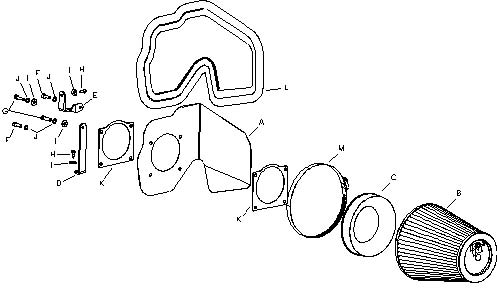
Parts List
| A | Heat Shield | 1 | 07421 |
| B | Filtercharger Element | 1 | RF-1048 |
| C | Adapter | 1 | 08785 |
| D | “L” Bracket | 1 | 07089 |
| E | “L” Twist Bracket | 1 | 07954 |
| F | 6mm-1.00 x 20mm Allen Bolt | 2 | 07852 |
| G | 6mm-1.00 x 25mm Allen Bolt | 2 | 07859 |
| H | Sheet Metal Screw | 2 | 07788 |
| I | Flat Washer | 4 | 08275 |
| J | Wave Washer | 4 | 08174 |
| K | Gasket | 2 | 09984 |
| L | Trim Seal 44”L | 1 | 102486 |
| M | Hose Clamp #104 | 1 | 08697 |
NOTE: FAILURE TO FOLLOW INSTALLATION INSTRUCTIONS AND NOT USING THE PROVIDED HARDWARE MAY DAMAGE THE INTAKE TUBE, THROTTLE BODY AND ENGINE.
TO START:
1. Turn the ignition OFF and disconnect the vehicle's negative battery cable.
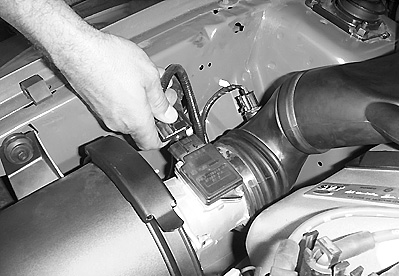
2. Disconnect the mass air sensor electrical connections.

3. Loosen the hose clamp on the intake tube at the mass air sensor.
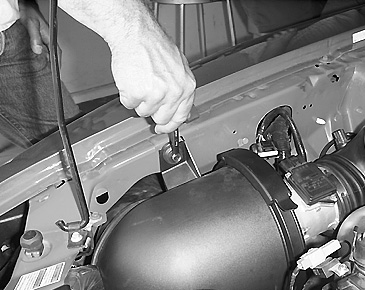
4. Loosen and remove the bolt that retains the air cleaner assembly.
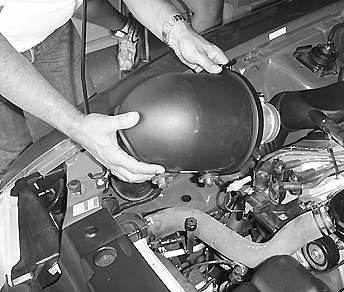
5. Pull the air cleaner assembly upward and remove from vehicle.
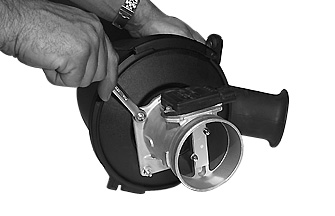
6. Loosen and remove the four nuts that retain the mass-air sensor to the air cleaner.
NOTE: It may be necessary to use a pair of vise grips to hold the studs while loosening the nuts.
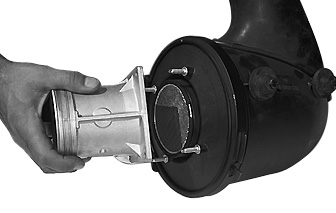
7. Remove the mass air sensor from the air cleaner.
NOTE: The screen will not be used.

8. Assemble the mass air sensor, adapter, gaskets and brackets using the hardware provided.

9. Install the mass air assembly into the intake tube.
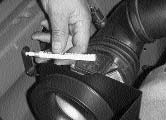
10. Align the brackets to the inner fender and lower fender then mark.

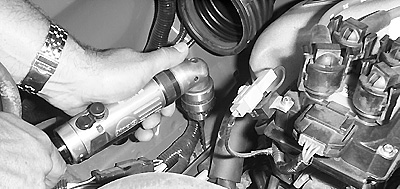
11. Remove the mass air assembly from the vehicle and using a 3/16” drill bit, drill out the two marks.

12. Install the trim seal onto the heat shield.
13. Reinstall the mass air assembly into the intake tube and secure the brackets with the sheet metal screws provided.
14. Tighten the hose clamp on the intake tube at the mass air sensor.
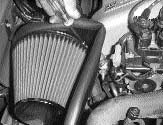
15. Install the filtercharger element onto the adapter and secure it with the hose clamp provided.
16. Reconnect the mass air sensor electrical connection.
17. Reconnect the vehicle’s negative battery cable. Double check to make sure everything is tight and properly positioned before starting the vehicle.
18. The C.A.R.B. exemption sticker, (attached), must be visible under the hood, so that an emissions inspector can see it when the vehicle is required to be tested for emissions. California requires testing every two years, other states may vary.
19. It will be necessary for all FIPK’s to be checked periodically for realignment, clearance and tightening of all connections. Failure to follow the above instructions or proper maintenance may void warranty.
Road Testing
1. Start the engine with the transmission in neutral or park, and the parking brake engaged. Listen for air leaks or odd noises. For air leaks secure hoses and connections. For odd noises, find cause and repair before proceeding. This kit will function identically to the factory system except for being louder and much more responsive.
2. Test drive the vehicle. Listen for odd noises or rattles and fix as necessary.
3. If road test is fine, you can now enjoy the added power and performance from your kit.
4. K&N suggests checking the Filtercharger element periodically for excessive dirt build-up. When the element becomes covered in dirt (or once a year), service it according to the instructions on the Recharger service kit, part number 99-5050 or 99- 5000.
Related Guides
-
Installation
-
Installation
-
Installation

